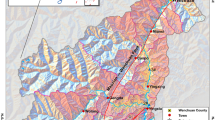Abstract
The design rainfall intensity and its return period of the combined interceptor sewer is an important factor affecting combined sewer overflow (CSO) occurrence. However, we often use the interceptor ratio (or interceptor multiple, n0) to design the interceptor sewer, and its equivalent design return period is often ignored. In this study, a low return period rainfall formula modeling method was proposed to estimate this return period. First, a new rainfall event separation approach was especially developed, and the minimum interevent time (MIET) was set to time of concentration of the tributary area corresponding to the most downstream interceptor well. Second, a new rainfall intensity sampling algorithm, annual multi—event—maxima (AMEM) sampling algorithm, was put forward. For this sampling algorithm, several maxima of rainfall intensity should be sampled annually, and only one maximum is sampled for each rainfall event. In addition, the empirical frequency values of the above sampled rainfall intensities can be obtained according to the mathematical expectation formula (Weibull formula). After comparison, the lognormal distribution was selected for the theoretical probability density function. Finally, parameters of the low return period rainfall intensity formula were estimated using three-parameter Horner formula and MCMC (Markov Chain Monte Carlo) algorithm. A case study was conducted to demonstrate the proposed method based on the recorded rainfall data from a meteorological station in southwestern China and a combined sewer system. Results revealed that: (1) A MIET determination method was proposed according to independence of CSO events. (2) An annual multi-event-maxima (AMEM) sampling was proposed for collecting samples of the low return period rainfall intensity. (3) For the case study, the best-fit distribution for low return period rainfall intensity was lognormal distribution. (4) Resulted low return period rainfall intensity formula was provided.






Similar content being viewed by others
Availability of Data and Materials
The authors confirm that some data are available from the corresponding author on reasonable request.
Abbreviations
- AMEM:
-
Annual multi-event-maxima
- AMS:
-
The annual maxima sampling
- CC:
-
Correlation coefficient
- Cs :
-
Coefficient of skewness
- CSO:
-
Combined sewer overflow
- Cv :
-
Coefficient of variation
- MCMC:
-
Markov Chain Monte Carlo algorithm
- MIET:
-
The minimum interevent time
References
Ahmad I, Khan DA, Almanjahie IM et al (2019) At-site rainfall frequency analysis using partial duration series and annual maximum series: A case study. Appl Ecol Environ Res 17(4):8351–8367
Andrés-Doménech I, Múnera JC, Francés F, Marco JB (2010) Coupling urban event-based and catchment continuous modelling for combined sewer overflow river impact assessment. Hydrol Earth Syst Sci 14(126):2057–2072
Gooré Bi EG, Monette F, Gachon P et al (2015) Quantitative and qualitative assessment of the impact of climate change on a combined sewer overflow and its receiving water body. Environ Sci Pollut Res 22(15):11905–11921
Jean MÈ, Duchesne S, Pelletier G et al (2018) Selection of rainfall information as input data for the design of combined sewer overflow solutions. J Hydrol 565:559–569
Lau J, Butler D, Schutze M (2002) Is combined sewer overflow spill frequency/volume a good indicator of receiving water quality impact? Urban Water 4(2):181–189
Li J, Xiang L, Wenliang W, Yaotang W (2019) Analysis of influence of rainfall interval on volume capture ratio of annual rainfall. China Water & Wastewater 35(9):120–126 (in Chinese)
Liu X, Xia C, Tang Y et al (2021) Parameter optimization and uncertainty assessment for rainfall frequency modeling using an adaptive Metropolis-Hastings algorithm. Water Sci Technol 83(5):1085–1102
Mailhot A, Talbot G, Lavallée B (2015) Relationships between rainfall and Combined Sewer Overflow (CSO) occurrences. J Hydrol 523:602–609
Passerat J, Ouattara NK, Mouchel J-M et al (2011) Impact of an intense combined sewer overflow event on the microbiological water quality of the Seine River. Water Res 45(2):893–903
Restrepo-Posada PJ, Eagelson PS (1982) Identification of independent rainstorms. J Hydrol 55(1–4):303–319
Rosin TR, Romano M, Keedwell E et al (2021) A committee evolutionary neural network for the prediction of combined sewer overflows[J]. Water Resour Manag 35(4):1273–1289
Weibull W (1939) A statistical theory of the strength of material. Stockholm: Ingeniors Vetenskapa Acadamiens Handligar 1–45
Yilmaza AG, Safaeta H, Huanga F et al (2014) Time-varying character of storm intensity frequency and duration curves. Australian Journal of Water 18(1):15–26
Yu Y, Kojima K, An KJ et al (2013) Cluster analysis for characterization of rainfalls and CSO behaviors in an urban drainage area of Tokyo. Water Sci Technol 68(3):544–551
Zhang C, Ma XL, Lu F et al (2016) Code for design of outdoor wastewater engineering(GB 50014). Beijing: China Planning Press: 1–248 (in Chinese)
Funding
This study was supported by the National Natural Science Foundation of China [Grant No. 51008191].
Author information
Authors and Affiliations
Contributions
Xingpo Liu designed the study, co-worte the the initial draft of the manuscript and made revisions to the draft. Chenmeng Ouyang performed the research and co-wrote the initial draft of the manuscript. Yuwen Zhou contributed to the revisions.
Corresponding author
Ethics declarations
Ethics Approval
This paper has neither been published nor been under review for publication elsewhere.
Consent to Participate
The authors have participated in the preparation of this paper for publication in the Water Resources Management.
Consent to Publish
The authors declare their consent to publication of the manuscript in “Water Resources Management” journal.
Competing Interests
Authors declare no conflict of interest.
Additional information
Publisher's Note
Springer Nature remains neutral with regard to jurisdictional claims in published maps and institutional affiliations.
Rights and permissions
Springer Nature or its licensor (e.g. a society or other partner) holds exclusive rights to this article under a publishing agreement with the author(s) or other rightsholder(s); author self-archiving of the accepted manuscript version of this article is solely governed by the terms of such publishing agreement and applicable law.
About this article
Cite this article
Liu, X., Ouyang, C. & Zhou, Y. A Low-Return-Period Rainfall Intensity Formula for Estimating the Design Return Period of the Combined Interceptor Sewers. Water Resour Manage 37, 289–304 (2023). https://doi.org/10.1007/s11269-022-03369-w
Received:
Accepted:
Published:
Issue Date:
DOI: https://doi.org/10.1007/s11269-022-03369-w




